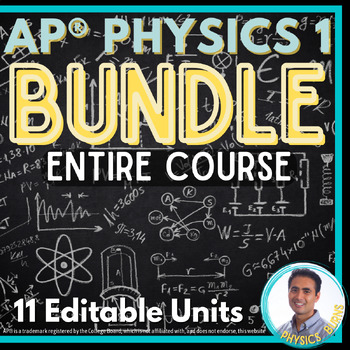AP® Physics 1 PPT - Entire Course Curriculum | Full Year Aligned
- Zip
What educators are saying
Products in this Bundle (17)
showing 1-5 of 17 products
Description
AP® Physics 1 Full Year Curriculum. This Lesson Plan bundle includes: PowerPoints, Homework, Quizzes, Reviews, Pacing Guide, Guided Notes, and Tests for every topic. Answers with explanations to everything. Everything is fully editable.
These are the exact lessons and assignments I give to my students in my classes. This bundle is for AP® Physics 1 students.
Every example problem has a Youtube video that shows how to solve each problem with tips and tricks to teach your students in the most effective way possible.
Here is a free resource that will help give you an idea of what to expect: Preview
Topics
- Kinematics
- Vectors
- Projectile Motion
- Dynamics (Newton's Laws)
- Uniform Circular Motion and Universal Gravitation
- Energy & Work
- Momentum
- Rotational Motion
- Simple Harmonic Motion
- Fluids
- Electrical Forces, Charges, and Field (This is a chapter I added for free, if you need material for after the AP® EXAM)
_____________________________________________________________________________________________
This Bundle DOES NOT Include Labs
If You Are Interested In Purchasing Labs: Entire Lab Bundle
_____________________________________________________________________________________________
AP® is a trademark registered by the College Board, which is not affiliated with, and does not endorse, this website.
Check out my Youtube Channel, Facebook Group, and Follow my Store :)
Email Me For Custom Bundles: Raymondburnseducator@gmail.com





